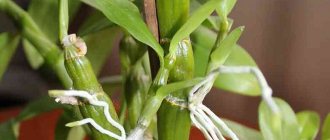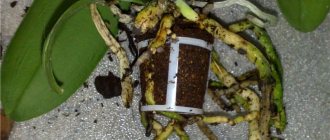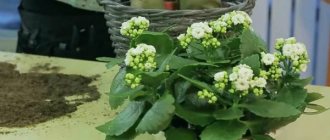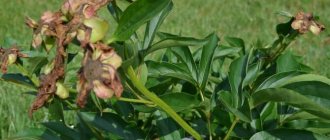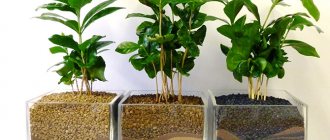Care after purchase
When the plant is just brought home, you need to send it to some kind of isolation for at least 2 weeks. Experienced flower growers recommend immediately replanting the flower in new soil to assess the condition of the roots and prevent diseases caused by possible incorrect care in the store.
After transplanting, the flower must be placed in a warm and bright place. The orchid should not be watered for at least four days after transplantation - if you cut the roots, the cuts may fester due to excess water.
So, two weeks passed, the flower took root well and showed no signs of disease. What kind of indoor care should I provide next? The orchid is a capricious flower native to the tropics. The whole essence of care comes down to organizing conditions that are similar in properties to the natural growing environment.
Difficulties in growing orchids
The orchid's buds and leaves fall off
Perhaps your orchid is not getting enough light or moisture. Humidify the air in the room, move the pot closer to the window, and eliminate drafts. Another reason for an orchid’s leaves to fall may be its proximity to ripe fruits: some of them, for example, apples, emit ethylene, which is very harmful to flowers. A friend of mine had such a case: the children were eating in the bedroom where there are orchids and plums, and in the morning the plant dropped several buds. Although it happens that orchids grow in the kitchen, where there are a lot of all kinds of products, and they feel great. In a word, depending on your luck, it’s better to play it safe and not leave fruit near them.
The leaves of the orchid began to ripple
or their edges have wrinkled. Perhaps the room is too hot, the orchid should feel a temperature difference between day and night of approximately 8 degrees.
Orchid roots peeking out of a flowerpot
It’s okay, it’s just time for the flower to move to a larger pot. But if the roots of the orchid dry out or rot, then urgent measures need to be taken.
Orchid leaves are limp
despite regular watering. Most likely, you overwatered your orchid! Or the pot is too narrow, and the root system of the flower is compressed. Another likely reason is too generous watering with long breaks.
Orchid doesn't bloom
Despite all your efforts, the orchid does not want to bloom. Most likely, the orchid needs the so-called “heat stress”, that is, the same temperature difference between day and night, which should be 8-10 degrees difference. Or maybe your flower just needs a rest.
And finally, a few more words in favor of these graceful and beautiful indoor plants. Orchids on the windowsill are also aromatherapy. The Pleione maculata orchid smells like apples, the Bulbophyllum picctuatum smells like watermelon, and the Cychnoches pentadactylon orchid smells like chocolate!
- Photo of saxifrage species from the name
In addition, according to the teachings of Feng Shui, orchids stimulate the creative functioning of the brain and help get rid of depression. And dark red orchids supposedly cure their owner of laziness and apathy.
Lighting
A wild orchid almost always receives diffused light. In this case, daylight hours last more than 12 hours. Therefore, it is worth choosing a place where there will be enough light, but at the same time not allowing direct sunlight to fall on the leaves.
It is worth taking care in advance to compensate for the insufficient duration of daylight hours: additional illumination with one 40 W light bulb is enough for the flower.
Temperature
In general, an orchid feels quite comfortable when indoors. The main thing is not to harm the flower with a random draft or air currents from the air conditioner: the orchid does not like cold air currents.
What to do with a plant without a root system?
It is quite difficult for a plant to survive without a root system, but this process is possible. In order to solve the problem, you need to inspect the bush, cut off all damaged areas, you need to remove all the rot, leaving nothing behind, otherwise it will spread to healthy places. The sections are coated with brilliant green or a solution of water and activated carbon, thus disinfection occurs and harmful bacteria do not spread throughout the plant.
Then the bush is placed in a ceramic or glass container, I use filtered and warm water, it must be changed every day, and the plant must be dried. It is also necessary to observe temperature and light conditions. The temperature in the room should be up to 27 degrees Celsius, and there should be plenty of lighting; such conditions are favorable for resuscitation of the root system.
Air humidity
The tropical forest is incredibly humid: such conditions cannot be created in an apartment without the use of greenhouse structures. But there is no need for such excesses - it is enough to periodically spray the indoor plant with a spray bottle.
When spraying, you need to irrigate the entire plant, avoiding only the inflorescence. The water must be settled, always at room temperature. It is necessary to spray the orchid 3-4 times a week.
Regularity of watering
Orchid roots are extremely sensitive to both excess and lack of water. Understanding how to water a flower without harming it comes with time.
Most gardeners recommend watering orchids using the immersion method. The roots of the plant are extremely sensitive to humidity levels, and this method is the safest of all possible.
If signs of overwatering appear, then you need to carefully remove the orchid from the pot and remove the rotten parts of the roots. The soil should be replaced, because the old soil will remain excessively wet and the rotting process will start with renewed vigor. Naturally, after therapeutic manipulations, it will be necessary to review the frequency of watering.
If, on the contrary, the flower does not have enough moisture, it will let you know by thinning and yellowing of the leaves, followed by their falling off, starting from the lowest ones.
How to care for different types - differences
Differences in care also depend on the type of plant. Each type requires a special approach.
Phalaenopsis
The most common type. It is important to maintain a temperature of 16 to 24 degrees. The humidity level is desirable 40-50%, lighting 9-10 hours on a shaded window. Watering - by immersing the pot in water. Feeding in winter - once a month. In summer, weekly during watering. The substrate must contain bark without peat and foam .
We recommend watching a video about the rules of caring for Phalaenopsis orchids:
Dendrobium
The main rule in care is the difference in temperatures in winter and summer. In summer the temperature ranges from 18-25 degrees, in winter 12-18. The humidity level required is higher than for phalaenopsis. Additional moisture, aquariums or wet pebbles are necessary. Watering mode is regular. Feeding during watering during the flowering period. The substrate consists of bark and moss.
We recommend watching a video about the rules of caring for Dendrobium orchids:
Cumbria
This species is demanding on lighting. Light is needed at least 12 hours a day. If there is not enough lighting in winter, it will get dark. A temperature difference is also necessary. 13-16 degrees at night and 17-23 during the day. The preferred substrate is bark, coconut fibers and coal . During the flowering period and the dormant period, the care requirements are different.
We recommend watching a video about the rules for caring for Cambria orchids:
Soil selection
The right soil is half of successful care. When selecting soil, you need to know exactly the variety of your flower. If you are not sure about the type of plant you have, you can use a photo of the orchid to determine as accurately as possible whether it is a terrestrial or arboreal species.
If the orchid is a terrestrial variety, then additional nutritional supplements will need to be added to the standard orchid soil mixture.
Similar additives can be humus or a mixture of charcoal and peat. But varieties that naturally grow on trees do not need soil with additional nutrients, but they do need soil that will not interfere with the evaporation of excess moisture.
You need to mix into the base soil elements that loosen the soil and increase air circulation in it, for example expanded clay, oak or pine bark, moss or even the husks of ordinary seeds.
Conditions necessary for maintaining a flower
When deciding to have an orchid in your home, it is necessary to create certain living conditions for it, namely, close to its natural content. It’s not that difficult, the most important thing is to monitor the temperature, humidity, and lighting of the room. It is also important to properly water and feed the plant, and the composition of the soil is also important.
When choosing a flower, remember that there are many types of phalaenopsis. They differ not only in appearance, but also in care requirements. Before choosing a flower, you need to familiarize yourself with the characteristics of each species.
Epiphytes are an ideal option for the home. This is a species of orchid that grows in the tropics, on trees and rocky soils. They have aerial roots that help with photosynthesis.
Fertilizing
For successful development, the flower must receive soluble mineral fertilizers containing phosphorus, nitrogen and iron.
It is worth purchasing a complex balanced fertilizer and applying it according to the manufacturer’s instructions.
Reproduction
Orchids reproduce both by seeds and through the separation of shoots. Growing at home from seeds is a labor-intensive process, almost impossible for an inexperienced gardener.
The fact is that orchid seeds do not contain nutrients due to their structural features, and therefore they germinate successfully only on a sterile nutrient medium.
A much more common method is to grow “babies” - young plants formed either on a peduncle, on a stem, or at the root. When a shoot is formed, it is necessary to add an additional portion of nitrogen fertilizers for the comfortable development of both the baby and the mother plant.
It is necessary to move the baby into adulthood after the formation of 2-3 leaves and at least a pair of horses at least 5 cm long. You need to separate the shoot with a sharp knife, after which the cut needs to be treated with charcoal to prevent rotting.
The separated shoot is planted in a pot; at first, a fine substrate should be used as soil. Caring for a young orchid is generally similar to caring for an adult plant. Flowering should not be expected until the second year of life, depending on the variety.
Features of caring for orchid roots
The roots of a plant are the main indicator that the flower is healthy, it has enough nutrients and moisture. The main rule is to carry out proper watering; you cannot over-water the roots; this procedure should be followed by drying to a reasonable extent. Photosynthesis constantly occurs in the roots, so the plant is sold in transparent containers, through such a surface it is easy to determine when it is necessary to water. If watering is necessary, the roots turn light gray.
Watering is carried out in an unusual way: the pot is immersed in a large container with settled water, which should be at room temperature. This procedure is mandatory before fertilizing; this will help protect the roots from burns by chemicals. If the roots of the plant have acquired an emerald hue, watering should be postponed, and a bright green color indicates that there is still enough moisture; its excess leads to rotting of the roots.
You should not plant the plant in ceramic pots, as the roots in them will become overcooled, as a result, photosynthesis slows down and the flower dies. If a ceramic container is a necessity, then you need to take a large pot and put a plastic container with the plant in it.
Transfer
The orchid needs to be replanted every 2 years. A complete change of soil and an increase in the volume of the pot are required.
Fresh soil is moistened in advance, the flower is transferred to a new pot, after which the plant must be left for three days in a place with a minimum of sunny color for comfortable adaptation. These three days the plant does not need to be watered.
Actions before and after flowering
When the buds open, the orchid requires special attention.:
- Even during the formation of buds, watering should be doubled.
- During the flowering period, the temperature at night should be increased by 5-7 degrees.
Actions after flowering:
- After flowering, you need to cut off the old peduncle.
- Feed the orchid with mineral fertilizer.
- During the dormant period, watering is reduced, the plant must gain strength for new flower stalks.
Yellowing leaves
The gradual death of the lower leaf is considered natural. If several leaves of a plant begin to turn yellow at the same time, this should be taken as an alarming signal.
First of all, inspect the plant for the presence of pests, and if none are found, then consider watering and feeding the orchid: most likely, it does not have enough nutrition.
Features of orchid aerial roots
Some people begin to panic when a plant develops aerial roots and try to plunge them into the soil or cut them off, which harms the plant. Aerial roots are just as natural as regular ones immersed in the ground. Almost the entire root system is called aerial. Internal and external roots differ in the thickness of the velamen; in aerial roots it is denser and can reach 20 layers. Aerial roots may indicate that the plant has too much moisture. If up to two roots emerge from the soil, this is considered normal, but if the entire root system tends to emerge, it is necessary to reduce watering. When there is too much water, the roots begin to rot and the plant dies.
Lack of flowers
It is worth understanding that a completely healthy plant will definitely bloom. Most often, adding abundant fertilizing during the growing season and changing lighting conditions helps.
First of all, try to increase the length of daylight hours - orchid flowers are even worth the additional costs of creating artificial lighting.
Fungi and rot
Due to excessive watering, rot or fungi sometimes appear. To get rid of them, it is necessary to cut off all affected areas as quickly as possible and treat the sections with a fungicide.
With the correct selection of growing conditions, all regular care will consist of timely watering. Understanding the right moment for watering comes with experience, and following other simple rules of care at home allows you to admire abundant flowering.


